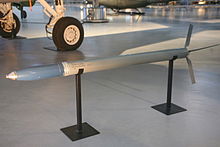Zuni (rocket)
The basic version of the Zuni is an unguided military rocket made in the USA , which can also be equipped with laser targeting .
It is an air-to-ground missile and can be equipped with various warheads , including chaff to defend against radar-guided missiles. The missile is usually fired from the LAU-10 missile container, which can hold four missiles.
description
The unguided missile Mk.71 is intended to combat soft targets such as troop concentrations, wheeled vehicles, radars, aircraft on the ground at airfields, lightly armored vehicles and bunkered positions. The rocket is designed for use from pipe launch containers and therefore has folding wings that unfold after launch, a so-called Folding Fin Aerial Rocket (FFAR). The rocket is 1.95 m long without a detonator, has a diameter of 5.0 inches or the equivalent of 127 mm and weighs around 36 kg without the warhead. It can be used in the temperature range from −40 ° C to +60 ° C. The burn time of the rocket propellant is 1.8 seconds. This achieves a speed of approx. 2600 km / h and a range of approx. 8 km. The rocket is painted white and has a brown band.
Mission history
The Zuni was mainly used in the Vietnam War by the US armed forces and their allies. Here it was mainly used by the US Navy by the aircraft Douglas A-4 , Douglas A-1 and the McDonnell F-4 .
On May 1, 1967, Lieutenant Colonel Theodore R. Swartz of the US Air Force shot down a North Vietnamese MiG-17 with a Zuni missile. Swartz received the Silver Star for shooting down.
The accidental firing of a Zuni rocket mounted on an F-4 was responsible for the outbreak of a large fire on the US aircraft carrier USS Forrestal in July 1967, killing 134 people. The missile hit the fuel tank of a refueled and armed A-4 Skyhawk . At this time, Lieutenant Commander John McCain was the pilot in a neighboring aircraft (see Forrestal disaster ). Another unplanned Zuni missile launch resulted in a fire on the US aircraft carrier USS Enterprise in 1969 that claimed 27 lives.
Use for research experiments
The Australian government donated its stocks of Zuni rockets to the Australian Space Research Institute (ASRI). ASRI uses the rockets for experimental research. In 1998 in particular, numerous Zuni missiles were used for tests on the launch area "LaunchArea: LA-9" in Woomera .
Zuni with laser search head
This version of the Zuni was developed by MBDA under the name SAL-Zuni . This missile is a Zuni missile with a semi-active WGU-58 / B laser homing head with four control surfaces attached to the tip . The maximum operating distance is around 8 km and the scatter circle radius ( CEP ) should be less than 1 m according to the manufacturer. SAL-Zuni is compatible with the existing Zuni systems and can be launched using the normal LAU-10 rocket tubular launch containers.
Warheads
The Zuni missiles can attack a wide range of ground targets. Depending on the nature of the target, different warheads can be screwed onto the missiles .
- Mk 24: Fragmentation warhead that generates 500 fragments. Length 45.5 cm, weight 20.4 kg. Can be equipped with a head or bottom igniter . Penetration performance of 51 mm armor steel , 900 mm reinforced concrete or 9 m of soil.
- Mk 32: shaped charge with fragmentation jacket. Length 26.8 cm, weight 20.2 kg. Penetration power around 450 mm armor steel. Additionally generates around 2000 splinters.
- Mk 33: Warhead for battlefield lighting . Weight 20.9 kg. Warhead with parachute . Generates 1.75 mega candelas for 70 seconds .
- Mk 34 mod 1: smoke / fire warhead. Length 23.8 cm, weight 22.1 kg. Filled with white phosphorus .
- Mk 34 mod 2: smoke / incendiary warhead. Length 23.8 cm, weight 22.1 kg. Filled with red phosphorus.
- Mk 63: fragmentation warhead that generates around 40,000 fragments. Length 72.9 cm, weight 25.7 kg. Splinter action circle of around 350 m
- Mk 84: Warhead for electronic countermeasures for radar deception. Warhead with chaff (Engl. Chaff). Length 24.1 cm, weight 20.8 kg.
Rocket launcher
The ZUNI missiles can be fired from two different missile tube units. The Lockley LAU-10 can also be fitted with aerodynamic caps at the front and rear of shorter missiles.
- LAU-33 / A (twin-tube rocket tubular launch container for two unguided ZUNI rockets)
- LAU-10 / A (rocket tube launch container for four unguided ZUNI rockets)
- LAU-10A / A (rocket tube launch container for four unguided ZUNI rockets)
- LAU-10B / A (rocket tube launch container for four unguided ZUNI rockets)
- LAU-10C / B (rocket tube launch container for four unguided ZUNI rockets, NAVY variant with heat-resistant coating)
- LAU-10D / B (rocket tube launch container for four unguided ZUNI rockets, NAVY variant with heat-resistant coating)
Launchers platforms
- MDD F / A-18A / B / C / D "Hornet"
- Boeing F / A-18E / F "Super Hornet"
- MDD AV-8A / B "Harrier"
- Vought F-8 "Crusader"
- Grumman A-6A "Intruder"
- Douglas A-4 "Skyhawk"
- LTV A-7 "Corsair II"
- General Dynamics F-16 "Fighting Falcon"
- Fairchild A-10 "Thunderbolt II"
- Northrop F-20 "Tigershark"
- Bell AH-1W "Super Cobra"
- OV-10A "Bronco"
Individual evidence
- ↑ Manufacturer information : MBDA Inc. data sheet Zuni ( Memento of April 8, 2011 in the Internet Archive ) (PDF, accessed on June 15, 2011; 145 kB)
- ↑ Australian Space Research Institute Overview of rocket launches ( Memento from February 18, 2011 in the Internet Archive ) (accessed June 15, 2011)
- ↑ Defensive review: MBDA Semi-Active Laser-Guided Zuni Rocket with 4-Shot LAU-10 Rocket Pod (Launch Pod): Precision-Guided Rockets Get a Big Boost
- ↑ MBDA-Systems: Direct Hit in Moving Target Demonstration of the Semi-Active Laser Guided Zuni Rocket
Web links
- Zuni 5.0-Inch (130 mm) Rocket - Description Page at the Military Analysis Network (English)
